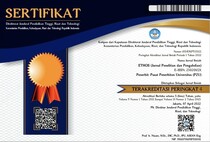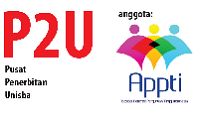Case Base Reasoning Untuk Mendiagnosis Penyakit Hipertensi Menggunakan Metode Indexing Density Based Spatial Clustering Application With Noise (DBSCAN)
Abstract
Abstract. Hypertension is one of the health problems priority in the world because of the increasing of life expectancy and an unhealthy lifestyle. Many people with hypertension are unreachable and undiagnosed by a health worker and they do not do treatment according to the health recommendation. The Case-Based Reasoning (CBR) Method can be applied to solve the new cases in diagnosed hypertension using the answer or experience from the old case by comparing the new case and the old case. In order to do not use all the basic case data for finding a similar case, it makes an indexing process is needed. The DBSCAN algorithm implementation as indexing method is expected to improve the time and memory efficiency in CBR, especially during the retrieval process. The result of the CBR test with the cluster-indexing has a better accuracy and time process than the non-indexing CBR. The minimum parameter points and epsilon that has been chosen for clustering on hypertension data case is the combination of epsilon score 9 and minimum points score 3 with the silhoutte coefficient score 0.240 and average cluster time 0.541 seconds. The Minkowski Distance method has better accuracy than the Euclidean Distance method because by the threshold score ≥ 0.9 the CBR system with the Minkowski distance method is able to diagnose the disease with 100 % accuracy and the average best retrieval time, it is 0.0586 second
Abstrak. Hipertensi menjadi salah satu prioritas masalah kesehatan di dunia karena peningkatan angka harapan hidup dan gaya hidup yang tidak sehat. Banyak penderita hipertensi yang tidak terjangkau dan terdiagnosis oleh tenaga kesehatan serta tidak menjalani pengobatan sesuai anjuran kesehatan. Metode Case-Based Reasoning (CBR) dapat diaplikasikan untuk menyelesaikan masalah baru dalam diagnosis penyakit hipertensi menggunakan jawaban atau pengalaman dari masalah lama dengan membandingkan kasus baru dengan kasus lama. Supaya proses pencarian kasus yang mirip tidak perlu melibatkan seluruh data pada basis kasus,maka diperlukan proses indexing. Implementasi algoritme DBSCAN sebagai metode indexing diharapkan dapat meningkatkan efisiensi waktu dan memori pada CBR khususnya ketika proses retrival. Hasil pengujian CBR dengan cluster-indexing memiliki akurasi dan waktu proses yang lebih baik dari pada CBR non-indexing. Parameter minimum points dan epsilon yang dipilih untuk melakukan clustering pada data kasus penyakit hipertensi adalah kombinasi epsilon 9 dan minimum points 3 dengan nilai silhoutte coeffisien 0.240 dan waktu klaster rata-rata 0.541 detik. Metode minkowski distance memiliki akurasi yang lebih baik dari pada metode euclidean distance, karena dengan threshold ≥ 0.9 sistem CBR dengan metode minkowski distance mampu mendignosis penyakit dengan akurasi 100% dan waktu retrieve rata-rata terbaik yaitu 0.0586 detik.
Keywords
Full Text:
PDFReferences
Dhianingtyas, Y., & Hendrati, L. Y. (2006). Risiko Obesitas , Kebiasaan Merokok , dan Konsumsi Garam. Media The Indonesian Journal of Public Health, 2(3), 2006.
Ester, M., Kriegel, H. P., Sander, J., & Xu, X. (2010). Density-Based Clustering Methods. Comprehensive Chemometrics, 2, 635–654. https://doi.org/10.1016/B978-044452701-1.00067-3
Firmansyah, R. S., Lukman, M., & Mambangsari, C. W. (2017). Faktor-Faktor yang Berhubungan dengan Dukungan Keluarga dalam Pencegahan Primer Hipertensi Analysis of Factors Related to Support Families in Primary Prevention of Hypertension. Jkp, 5, 197–213.
Furqon, M. T., & Muflikhah, L. (2016). Clustering the Potential Risk of Tsunami Using Density-Based Spatial Clustering of Application With Noise (Dbscan). Journal of Enviromental Engineering and Sustainable Technology, 3(1), 1–8.
https://doi.org/10.21776/ub.jeest.2016.003.01.1
Han, J., & Kamber, M. (2006). Data mining concept and technique. Morgan Kaufmann (2nd ed.). San Francisco: Morgan Kaufmann. https://doi.org/10.1017/CBO9781107415324.004
Kim, K. S., & Han, I. (2001). The cluster-indexing method for casebased reasoning using self-organizing maps and learning vector quantization for bond rating cases, Expert Systems with Applications. Expert Systems with Applications, 21(3), 147–156. https://doi.org/10.1016/S0957-4174(01)00036-7
Labellapansa, A., Efendi, A., Yulianti, A., & Evizal, A. K. (2016). Lambda value analysis on Weighted Minkowski distance model in CBR of Schizophrenia type diagnosis. 2016 4th International Conference on Information and Communication Technology, ICoICT 2016, 4(c), 1–4. https://doi.org/10.1109/ICoICT.2016.7571898
Merigó, J. M., & Casanovas, M. (2011). A new minkowski distance based on induced aggregation operators. International Journal of Computational Intelligence Systems, 4(2), 123–133. https://doi.org/10.1080/18756891.2011.9727769
Mohsin, M. F. M., Manaf, M., Norwawi, N. M., & Wahab, M. H. A. (2011). Faster Case Retrieval Using Hash Indexing Technique. International Journal of Artificial Intelligence and Expert Systems (IJAE), 2(2), 81–95.
Mulyana, S., & Hartati, S. (2009). Tinjauan Singkat Perkembangan Case – Based Reasoning. semnasIF UPNVN Yogyakarta, 2009(semnasIF), 17–24.
Núñez, H., Sànchez-Marrè, M., Cortés, U., Comas, J., Martínez, M., Rodríguez-Roda, I., & Poch, M. (2004). A comparative study on the use of similarity measures in case-based reasoning to improve the classification of environmental system situations. Environmental Modelling and Software, 19(9), 809–819. https://doi.org/10.1016/j.envsoft.2003.03.003
Pal, S. K., & Shiu, S. C. (2004). Foundations of Soft Case-Based Reasoning. John Willey and Sons, Inc. Hoboken, New Jersey: John Willey and Sons, Inc. https://doi.org/10.1016/S0261-5614(03)00132-8
Parimala, M., Lopez, D., & Senthilkumar, N. C. (2011). A survey on density based clustering algorithms for mining large spatial databases. International Journal of Advanced Science and Technology, 31(1), 59–66. https://doi.org/10.1002/14651858.CD009067
Rismawan, T., & Hartati, S. (2012). Case-Based Reasoning untuk Diagnosa Penyakit THT (Telinga Hidung dan Tenggorokan). Indonesian Journal of Computing and Cybernetics Systems (IJCCS), 6(2), 67–78. https://doi.org/10.22146/ijccs.2154
Rousseeuw, P. J. (1987). Silhouettes: a graphical aid to the interpretation and validation of klaster analysis. Journal of Computational and Applied Mathematics, 20, 53–65. https://doi.org/10.1177/003754977702900403
Tedjasukmana, P. (2012). Tata Laksana Hipertensi. Cermin Dunia Kedokteran, 39(4), 251–255.
Triyanto, E. (2014). Pelayanan Keperawatan bagi Penderita Hipertensi Secara Terpadu. Yogyakarta: Graha Ilmu.
Whitworth, J. A. (2003). World Health Organization (WHO) International Society of Hypertension (ISH) statement on management of hypertension. Journal of Hypertension, 21(11), 1983–1992. https://doi.org/10.1097/01.hjh.0000084751.37215.d2
Witten, I. H., & Frank, E. (2005). Data mining: practical machine learning tools and techniques. Burlington, USA: Morgan Kauffmann. https://doi.org/0120884070, 9780120884070
Zhu, S., Wu, J., Xiong, H., & Xia, G. (2011). Scaling up top-K cosine similarity search. Data and Knowledge Engineering, 70(1), 60–83. https://doi.org/10.1016/j.datak.2010.08.004
DOI: https://doi.org/10.29313/ethos.v7i1.4206
Refbacks
- There are currently no refbacks.
Alamat Redaksi:
LPPM Unisba, Lantai 2, Jl. Purnawarman 63, Bandung 40116, Jawa Barat, (022) 4203368 , (022) 4264064. ethos.unisba@gmail.com / ethos@unisba.ac.id

This work is licensed under a Creative Commons Attribution-NonCommercial-ShareAlike 4.0 International License.














